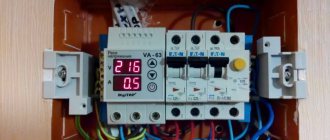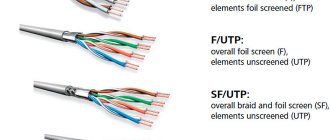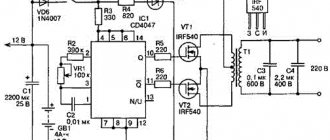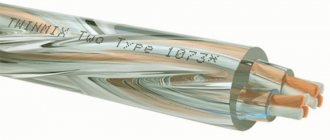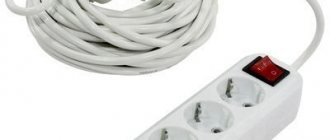Features of working with automotive inverters
Connecting a load to the inverter leads to a natural discharge of the car battery, so it is important that the inverter has an automatic shutdown function when the minimum permissible voltage value of 10.5 ± 5V is reached at the input (car battery terminals).
Maintaining the operating condition of the inverter and the car battery for a long time directly depends on the operation of this combination of devices, the practice of which largely depends on periodic recharging of the car battery. The total power of consumers at the output of an operating inverter should not exceed the load allowed for this type of inverter.
The power indicated on the inverter packaging is very relative, so when purchasing it is better to choose an inverter with a large power reserve. For example, having bought an inverter with an output power of 350 W, I was sure that it would be enough not only to power a laptop, but also (if necessary) for lighting with a 220 V/60 W incandescent light bulb (as the sales consultant assured).
In neither case did my hopes come true.
Both when the car engine was turned on (idle speed) and when the car engine was turned off (the voltage at the inverter input was 12.5 V and 11.8 V, respectively), the inverter “did not pull” the load indicated above. The internal protection is triggered, shutting down the inverter. For the above load, it was necessary to use an inverter with an output power (declared by the Chinese manufacturer) as much as 450 W. That is, for reliable operation of a laptop, an inverter with a declared power of at least 450 W is required. Let's figure out why this happens.
At idle engine speed (approximately 750 rpm), the power of the car generator will be 300-550 W (current 20-40 A). At average engine speeds (2000-3000 rpm), the output power is approximately 560-1400 W, which corresponds to a current of 40-100 A at a rated voltage of 12-14 V.
It is this “reserve” that can power the inverter.
If the power of the inverter (for example, due to load power) exceeds the power of the generator, the difference in energy is covered by the battery’s own “reserves”, and they do not last forever.
In extreme cases, the consumer can use the car's engine for some time to recharge the battery at idle, and "ideally" should not turn on the engine at all to recharge.
When the inverter (and load device) is connected to the battery for a long time (more than 2 hours) (with the engine not running), the latter is noticeably discharged. In this case, you will need to force start the engine approximately once every 2 hours and let it idle for 10-15 minutes. In this case (as after any strong discharge), the battery will be charged from the car's generator with a current of 30-40 A, which is not advisable to do systematically in order to preserve the battery.
For example in table. 2.1 and 2.2 present the calculated values of the battery discharge time depending on the power of the energy consumer (using the example of a fully charged average static battery ST-55, with a nominal capacity of 55 A/h).
Table 2.1. Estimated battery discharge time (up to the maximum permissible value of 10.5 V) when connected to a consumer's cigarette lighter socket with a power of 170 W
It is better to first turn on the inverter to the car battery, and only then connect the load to it.
Recently, the following incident occurred in my foreign car: due to vibration, the contact between the flexible conductor and the output of the piezoelectric capsule was broken, and since this happened in an important life support system of the car, the incident immediately caused my discomfort.
Since the place where the soldering iron could be connected to a 220 V network was very far away, and the malfunction required immediate elimination, we had to use ingenuity to help. I had to connect the contacts (twisted capsule lead and connecting conductor) and heat the connection point with a lighter flame for 1 minute. If there is no possibility of twisting, it would be necessary to press the contacts tightly against each other and then heat them with a flame.
Practice has shown that such a connection cannot be broken (no worse than using tin and rosin). In any case, in field conditions there is no better method than this. Unless there is a more modern method.
Carry a soldering iron (rosin, soldering acid and solder) and the inverter discussed above in your car. For example, a 450 W converter (costs up to 1000 rubles) can (with the car engine turned off) power a laptop and be used for a limited time as a power source for a soldering iron. The load for the inverter must be active.
Literature: Kashkarov A.P. Electronic devices for coziness and comfort.
Source
Steps for connecting batteries to solar power plant equipment
The connection occurs in stages, usually in the following order: first, the controller is connected to the battery, then the controller is connected to the solar panels, then the battery is connected to the inverter, and lastly, the wiring is done to consumers.
Step #1: Connecting to Battery
Batteries occupy a clearly defined place in the network. They are not connected to the solar panels directly, but through a controller that regulates their loading/unloading. On the other hand, the battery pack is connected to an inverter that converts the current.
Thus, the diagram for connecting solar panels to a battery looks like this:
- We connect the battery/controller (then the controller/solar panels);
- connect the battery and inverter.
Other connection options are possible, but this one is optimal, since the battery stores unspent energy and, if necessary, supplies it to consumers.
If one battery is not enough, purchase several batteries with the same characteristics. They are installed in one place and connected in series.
For ease of use and maintenance, the blocks are installed on a metal rack with a polymer coating.
Let's look at how the battery is connected to the controller and inverter.
The next step is to connect the controller to the solar panels and the battery pack to the inverter.
Communities › Auto electrics › Blog › Installing an inverter, advice needed.
Good afternoon, dear Drayvovites.
Quote: “For auto electricians, all wires are divided into two categories: “Like this one” and “Holy crap.” Joke.
I need advice on installing an auto-inverter, so I’m writing to a specialized community with a question.
It is necessary to install an inverter in a Honda Civic car Model: REDMOND RIA-5012
Specifications:
Input voltage 12 V Output voltage 220 V Output power (nominal) 500 W Output power (maximum) 1000 W Power of connected devices 400 W Output voltage USB 5 V Fuses 2 x 30 A Output efficiency 90.5% Output signal: modified sine wave Outputs : universal Euro socket, USB port Housing material: aluminum alloy with high thermal conductivity Contents: — Inverter — 2 connecting wires of 2 meters each — instruction manual — service book Additional features: Forced cooling 12 month warranty
It needs to be installed permanently, that is, by running the wires from the battery into the interior, and screwing them to the battery on special terminals.
2.
I already roughly found out how to run the wire, in the company of Civic gadflies of the previous generation, who ran the power wire to the subwoofer in the trunk.
But I can’t pinpoint a few things for myself. 1. What size wire should I choose?
Will speaker wires like these be suitable for me? Or is this an extra overpayment, can I use a regular household cable?
2. Do I need to install an additional protective flask?
Or is a 2 30 Amp fuse in the inverter itself sufficient?
3. Well, the last question, please advise.
During quarantine, when all the stores are closed, where can you buy cables, terminals, etc.?
Thanks in advance for your answers.
Battery voltage
For “green systems”, as well as other backup power needs, 12 Volt batteries are most often used, as well as assemblies of several 24 and 48 Volt units. To avoid imbalance, in any way of combining batteries, it is recommended to use monoblocks of the same type with the same production date. When you order 2 pieces or more from us at the same time, we always issue batteries from the same batch without additional clarification from the buyer.
Twelve-volt monoblock batteries are well suited for uninterruptible power supply systems for low-power consumers, i.e. if you need to connect a small wind generator or a couple of solar panels. We do not recommend limiting yourself to this voltage when the planned power exceeds 1.5 kW.
Twenty-four volt systems have proven themselves well with a total power of up to 4 kW. This rating is suitable for most solar panels with a rated voltage of 36-38 Volts.
Well, forty-eight volt battery stacks are effective solutions for serious problems. Such a system is enough to provide electricity to a large private home or small office. They provide good efficiency and allow the use of cables up to 120 mm2.
Tags: inverter, honda civic
Comments 69
I don’t know if it’s relevant, but I’ll write it. You cannot install the inverter under the hood. It is not sealed. If you seal it, it can overheat. The inverter can be placed under the front seat. This way there will be less wire left. Connect with a 10-16 mm2 cable. to the battery through a fuse (no further than 30cm from the battery). It can be made like a webast or hydronic - next to the battery there is a fuse + an 80A relay, controlled from inside the car. Then the inverter power cable will be energized only when needed. The cable cross-section is selected on the principle that a short circuit to minus anywhere in the cable line will cause the fuse to burn out; the short circuit current must be greater than the fuse rating. Also, the voltage on the supply wire should not drop below the voltage at which the inverter will stop working. It’s better not to allow such strong subsidence at all. The terminals will need to be crimped using heat shrink with glue, it will protect them from corrosion. You can also use spray for electrical contacts at the crimp point.
Well, the final touch to what has been said. If you use a tablet for music in the car and connect it via charging to the inverter, the parasitic noise will disappear. The sound will be clear and sound perfect. (This is a terrible secret). Don’t tell anyone, many people cannot overcome the hissing sound when charging the tablet.
Does this have anything to do with modified sinus?
Thus, we break the galvanic connection between devices
If the inverter is like in the photo, it is better to use original crocodiles and carry an extension cord with you. It's definitely safe.
Well, everyone studied at school! Finding the current, knowing the power and voltage, is elementary.
Output power (nominal) 500 W Output power (maximum) 1000 W Power of connected devices 400 W Fuses 2 x 30 A Output efficiency 90.5%
The Chinese, of course, turned down 1000 W... 500 no more, but then they themselves add devices up to 400 W. In general, we divide 500 W by the minimum voltage (taking into account the voltage drop on the wires), which can be 12 V, we get 42 A. The efficiency is 90%, which means we add 10% for losses, we get a current consumption of 46 A. This is the current you need to navigate to select the wire cross-section and fuse.
Based on the installed 2 x 30 A fuses, we understand that they are installed in parallel. Those. 60 A fuse. Now it fits. Looks like it's true.
With a wire length of 4 m, the cross-section must be at least 16 mm2, with a wire length of 6 m - the cross-section must be at least 25 mm2, with a length of 10 m - at least 35 mm2. The length must be taken as the total length of both wires! Therefore, it is in your interests to make them as short as possible, and not to pull the second wire to the negative of the battery, but to connect it in the nearest place with a bolt to the car body.
With such a long line, it is imperative to install a fuse at the beginning of the line (near the battery) (short circuit and fire have not been canceled)! The rating is the same as on the 60 A converter.
There’s not even anything to add! ...But no, there is - the acoustic wires definitely won’t work! )))
why won't they fit? I powered the fog lights at 45 W with acoustic wires (I think they were from the audio system) It’s copper, and in Africa it’s copper. The cross section is exactly the same as the factory ones.
African copper is, of course, good, but “African” insulation of audio wires under power load is not at all the same - the melting point is low, it doesn’t treat fuel and lubricants very well, it doesn’t particularly like temperature changes... A little bit and a short circuit is not far away!
Well, everyone studied at school! Finding the current, knowing the power and voltage, is elementary.
Output power (nominal) 500 W Output power (maximum) 1000 W Power of connected devices 400 W Fuses 2 x 30 A Output efficiency 90.5%
The Chinese, of course, turned down 1000 W... 500 no more, but then they themselves add devices up to 400 W. In general, we divide 500 W by the minimum voltage (taking into account the voltage drop on the wires), which can be 12 V, we get 42 A. The efficiency is 90%, which means we add 10% for losses, we get a current consumption of 46 A. This is the current you need to navigate to select the wire cross-section and fuse.
Based on the installed 2 x 30 A fuses, we understand that they are installed in parallel. Those. 60 A fuse. Now it fits. Looks like it's true.
With a wire length of 4 m, the cross-section must be at least 16 mm2, with a wire length of 6 m - the cross-section must be at least 25 mm2, with a length of 10 m - at least 35 mm2. The length must be taken as the total length of both wires! Therefore, it is in your interests to make them as short as possible, and not to pull the second wire to the negative of the battery, but to connect it in the nearest place with a bolt to the car body.
With such a long line, it is imperative to install a fuse at the beginning of the line (near the battery) (short circuit and fire have not been canceled)! The rating is the same as on the 60 A converter.
Thank you for the clarification. Very intelligible. It should come with two-meter wires (they should because the goods are still on the way). I'll look at their cross-section and maybe they'll be enough for me. I'll just replace the crocodiles with terminals.
They correctly wrote to you below that it is better to run a 220 V line, not a 12 V line. In a 220 V line, the current is much lower (500 W divided by 220 V gives 2.3 A in total), a large cross-section of wires is not required.
Try placing the converter closer to the battery, but in the passenger compartment, not in the engine compartment, it is not sealed and will not last there for long! For example, near the entry of wires from the battery into the passenger compartment. And then stretch thin wires to the 220 V outlet.
Yes, that’s what I thought, there seems to be a place behind the glove compartment in the area of the cabin filter, so I’ll try it on.
The inverter needs very good cooling. Installed in the depths will not last long, at a load above half. And he needs to do an audit to see what the Chinese have done.
Yes, it’s understandable that it needs to be placed in a well-cooled place; probably some kind of brackets need to be invented to keep it in the air. I don’t know where exactly yet, but there’s a lot of free space behind the glove compartment, no other ideas yet.
Well, everyone studied at school! Finding the current, knowing the power and voltage, is elementary.
Output power (nominal) 500 W Output power (maximum) 1000 W Power of connected devices 400 W Fuses 2 x 30 A Output efficiency 90.5%
The Chinese, of course, turned down 1000 W... 500 no more, but then they themselves add devices up to 400 W. In general, we divide 500 W by the minimum voltage (taking into account the voltage drop on the wires), which can be 12 V, we get 42 A. The efficiency is 90%, which means we add 10% for losses, we get a current consumption of 46 A. This is the current you need to navigate to select the wire cross-section and fuse.
Based on the installed 2 x 30 A fuses, we understand that they are installed in parallel. Those. 60 A fuse. Now it fits. Looks like it's true.
With a wire length of 4 m, the cross-section must be at least 16 mm2, with a wire length of 6 m - the cross-section must be at least 25 mm2, with a length of 10 m - at least 35 mm2. The length must be taken as the total length of both wires! Therefore, it is in your interests to make them as short as possible, and not to pull the second wire to the negative of the battery, but to connect it in the nearest place with a bolt to the car body.
With such a long line, it is imperative to install a fuse at the beginning of the line (near the battery) (short circuit and fire have not been canceled)! The rating is the same as on the 60 A converter.
Andrey, my calculation still doesn’t add up. The set includes wires “-” 2 meters “+” 2 meters cross-section 6mm2. The terminals say 50A. They are declared by the manufacturer up to a power of 400W. those. this is 37 A (Taking into account 0.9)
I have 8mm2 AWG wire length 2+2 - how much current will it pull? The fuse according to the table is 50A.
There is a version KG 1-16 16mm2 length 2+2, but its insulation is not very good and it is difficult to pull. The fuse according to the table is 80A.
The maximum current in the device, as we found out from the fuses, is 60A (650W), but I really need a maximum of 47A (500W). Constantly in long-term mode I will use no more than 37A (400W)
So what is the minimum wire size I should install and what fuse should I use to protect it?
Source
Instead of a conclusion: do you really need an inverter?!
In fact, this is a very difficult question that you must understand first.
For example, for all mobile devices you definitely have charging banks that will extend their life by several days. It’s the same story with modern laptops, and normal portable speakers will last for days on a single charge.
However, you may not have the newest laptop, a camera battery charger, home speakers that can be used on the go, and other gadgets for which an inverter outside the city will be a real godsend .
As is tradition, write your opinion about the socket in the car. An absolute must-have or insanely useless nonsense?
(
2 votes, overall rating: 4.50 out of 5)
